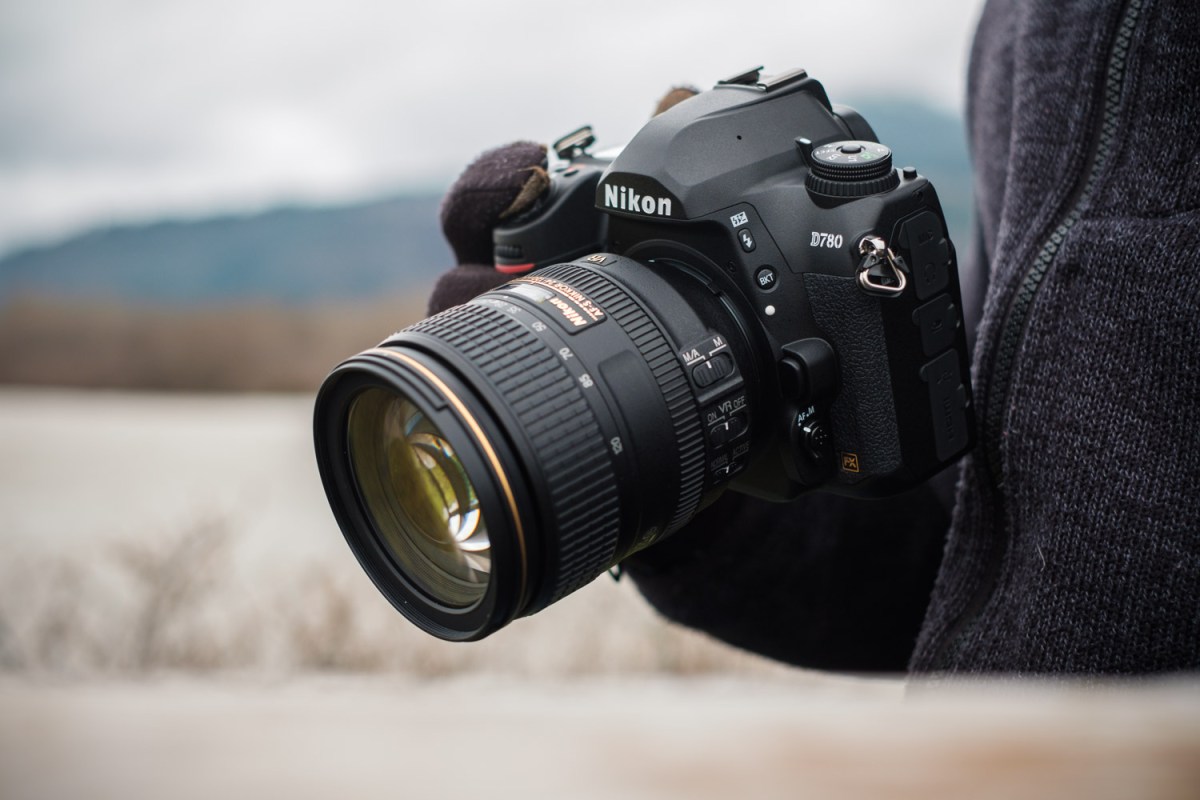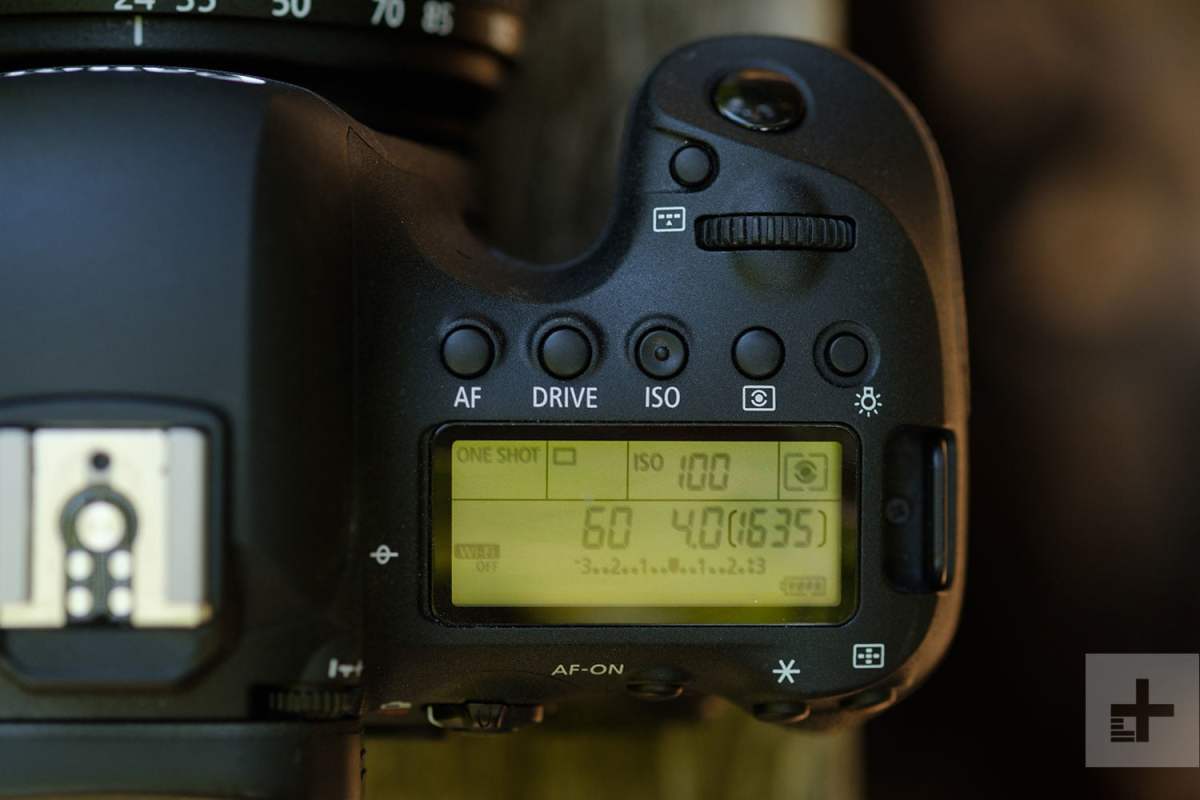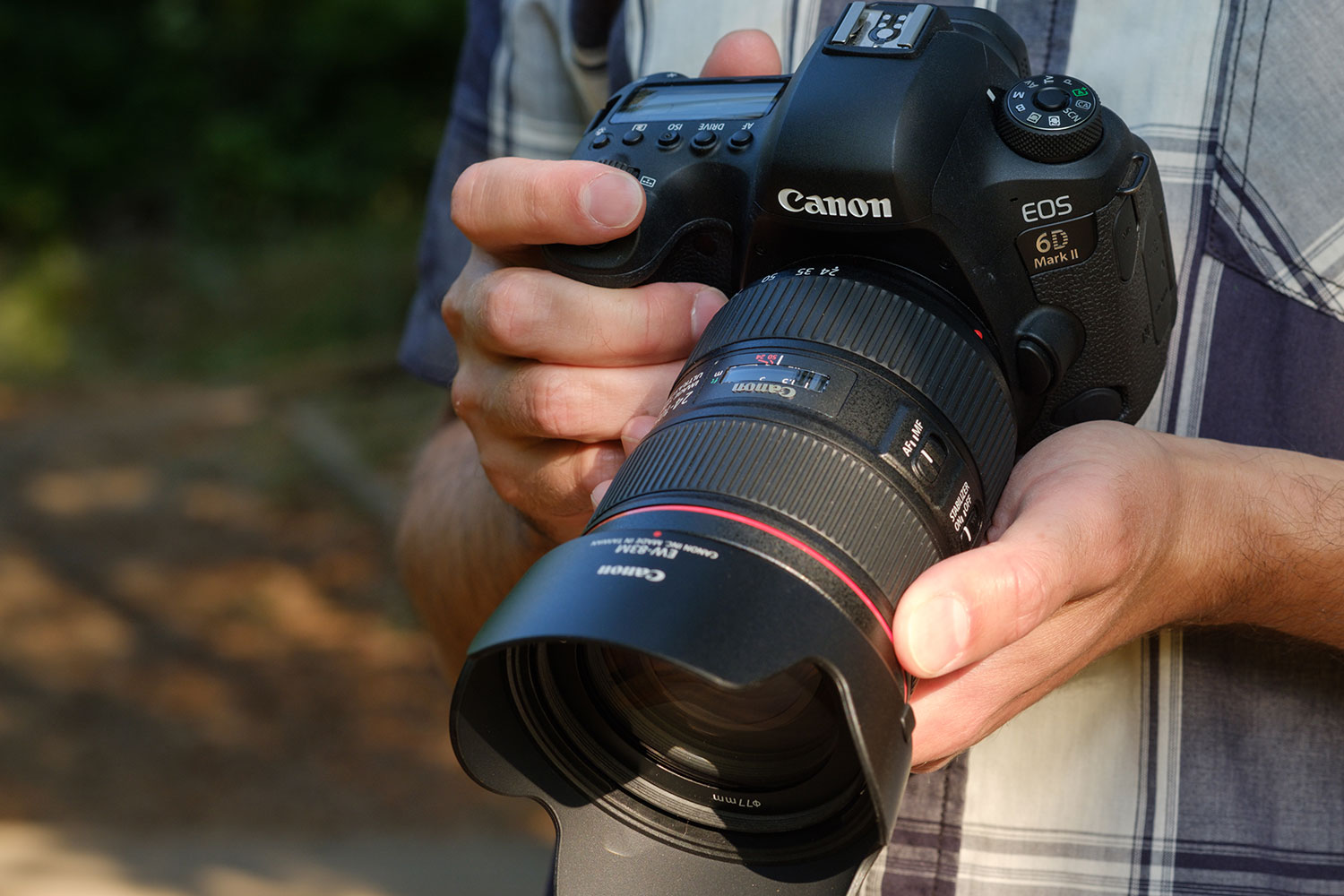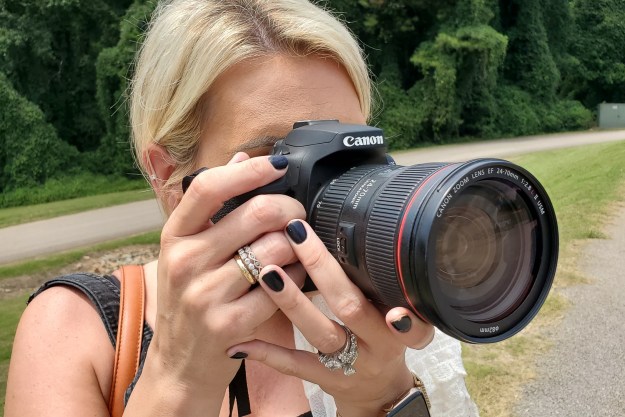The Canon versus Nikon debate has been raging for decades. Mirrorless cameras have diluted the competition and introduced new teams, but the Canon/Nikon rivalry runs deep. The latest battleground revolves around entry-level full-frame DSLRs, the Canon EOS 6D Mark II and the Nikon D780.
We use the term “entry-level” loosely. These cameras may be the cheapest full-frame DSLRs in each company’s lineup, but they are both robust machines with many pro-level features. Canon released the 6D Mark II in 2017 that kept pace with Nikon’s older D750 and one-upped it with better live-view features. The Nikon D780 came out in 2020 to finally replace the D750, with Nikon looking again to take the crown among entry-level full-frame DSLRs.
Despite pushing their new mirrorless systems, both Canon and Nikon are determined to keep the DSLR alive — at least for now. That’s what we have here; two old-school DSLRs that refuse to be pushed aside by a new generation of smaller, trendier cameras. Being newer, the D780 has some clear advantages, but the 6D Mark II is now much more affordable. If you’re not already cemented into one brand, this could be a tough decision.
For more information, read our full Canon EOS 6D Mark II and Nikon D780 reviews.
Sensor
The 6D Mark II is fitted with a 26-megapixel full-frame sensor with a native ISO range of 100 to 40,000, and it won’t disappoint in low-light shooting conditions. You can extend the ISO up to 102,400, but you’re going to see a dramatic reduction in image quality.

The Nikon D780 gets you 24MP full-frame sensor, but its 2MP which is also backside illuminated (BSI) for better light sensitivity. Nikon boasts that the BSI design reduces noise levels and adds extra clarity to the images produced with the camera. The native ISO range goes a little higher than 6D Mark II, starting at 100 and topping out at 51,200. The ISO can be extended to 204,800, twice the amount of the Mark II, but again, images shot at this extreme won’t look great.
Both cameras are capable of producing excellent image quality, but if you want to get into the nitty gritty, the Nikon does offer more dynamic range at base ISO and slightly better noise levels throughout the ISO range. That means you can preserve more detail in the highlights and shadows of an image and push the files further in postproduction, but it doesn’t mean pictures automatically look better out of the D780.
Autofocus
We were extremely impressed with the autofocus when we tested the Candon 6D Mark II. It has a 45-point all cross-type AF system, which is both fast and accurate. The downside, however, is that the autofocus points don’t cover the entire frame — it’s not even close.

The story isn’t very different for the Nikon, where the viewfinder autofocus also doesn’t extend to anywhere near the edge of the frame. It does have more points, however, with 51. Although the same AF module as the D750, Nikon has updated it with the high-performing algorithm from the flagship Nikon D5 (now superseded by the D6).
Despite not being anything revolutionary, we were impressed with the D780’s accuracy using 3D tracking mode. It kept up with a moving subject without issue, even while shooting at 7 frames per second. This feature is sure to attract action and wildlife photographers, even if the D780 wouldn’t be our first choice as a sports camera.
If you prefer not to use the viewfinder, and use live-view mode instead, you’re going to see both these cameras excel when it comes to autofocus. The 6D Mark II uses Dual Pixel Autofocus (DPAF), Canon’s flavor of on-chip phase-detection that had outclassed Nikon for generations — until now.
Nikon, who for many years just couldn’t get live view autofocus right, has raised its game. The D780 is the first Nikon DSLR to feature on-chip phase-detection. Autofocus is fast and accurate, and the eye-detection (a feature the 6D Mark II lacks) even worked on a subject wearing dark sunglasses. This is a game-changing feature for portrait photographers.
Compared to the viewfinder systems, the live-view autofocus in both cameras also covers much more of the frame. The downside is that viewfinder autofocus remains better for keeping up with moving subjects, especially for burst shooting, so neither system is perfect.
Shutter

Although not every photographer will need it, the Nikon has an advantage in the shutter speed department. The D780 can shoot anywhere from 1/8000 second to a full 15 minutes, where the Canon has a more limited 1/4000 to 30-second range. The faster shutter on the D780 will appeal to those who need tack-sharp images of very fast-moving subjects, while the 15-minute option opens up options for long-exposure photography and capturing star trails.
To be clear, the 6D Mark II can leave its shutter open longer in bulb mode or when using an external shutter timer, but the D780 lets you do more without requiring an extra accessory.
For those that shoot in burst mode, again, Nikon pips this one. Although Canon upgraded its performance in the 6D Mark II to 6.5 fps (its predecessor only shot at a disappointing 4.5 fps), it’s still behind the D780 at 7 fps. That’s a very minor difference, but the D780 can also hit 12 fps in live view using the electronic shutter (if you shoot JPEG or 12-bit RAWs).
As for shooting bursts with the Canon in live view, we wouldn’t bother. It fails to keep up, shooting at just 2 fps.
Video

On average, Canon has always outdone Nikon when it comes to shooting video. That’s not the case here, though. Showing it’s not quite up to speed with the times, the Mark II is only capable of capturing Full HD video (1,920 x 1,080) at a top frame rate of 60fps. The 6D does have a fully articulating screen, however, which is useful for vlog-style productions.
The D780 essentially has the same video features as the mirrorless Nikon Z 6, shooting 8-bit 4k video (3,840 x 2,160) at 24 or 30 fps internally or 10-bit into an external HDMI recorder. The D780 also includes Nikon’s N-Log flat color profile, making it a decent choice even for advanced video shooters.
Both systems have a recording limit of 30 minutes, a built-in microphone, and the option of attaching an external microphone for improved sound quality. Only the D780 has a headphone jack, however.
Design

When it comes to the design of a DSLR, innovation has certainly been lacking over the years. Alternately, you could say why fix what isn’t broken? DSLRs continue to be robust, durable machines, even if they aren’t pretty on the eyes. Both of the these cameras are weather-sealed and built extremely well. Even if they don’t expressly target professional photographers, they should easily stand up to professional wear and tear.
As far as control layouts go, which is better comes down to personal preference. If you shoot through the viewfinder, then you’ll want to access certain actions without having to take the camera away from your eye. The row of function buttons on the top right of the 6D Mark II might feel more comfortable for this. Live view shooters, however, may enjoy being able to see each button they press when using the camera, and the D780 puts more buttons on the back.
Neither camera has all of the features would have liked, however, like an AF joystick. Also missing are the built-in flashes. That may annoy some, but if you’re serious about flash photography, then your best option is to purchase an external flash to attach to the camera’s hot shoe.

As for the LCD screen, both are touch-sensitive. Again, the Canon has a vari-angle LCD, perfect for shooting vlogs and selfies, even if doing so with a DSLR would feel a bit awkward. The Nikon screen only tilts up and down, but will be useful if you’re shooting from high or low angles. The Nikon screen is also much sharper, with 2.35 million pixels compared to the Canon’s 1.04 million.
If you’re looking for a bicep workout, then these cameras should give you the pump you need. The Nikon D780 weighs in at nearly 30 ounces, while the Mark II is bit lighter at 24. Unlike mirrorless cameras, it’s extremely hard to make a DSLR light and compact due to the bulky mirror box, prism, and viewfinder.
Storage and battery life
The 6D Mark II offers only one card slot compatible with UHS-I SD cards. The Nikon D780 comes with two card slots that support faster UHS-II media. SD cards are very large today, so a single slot isn’t a huge disadvantage, but we appreciate how the D780’s dual slots can be used to split RAW and JPEG files, stills and movies, or just as an automatic backup — something that will be attractive to wedding and event photographers and photojournalists.
As for battery life, this is one big advantage of DSLRs over mirrorless cameras, but the Nikon has a clear edge over the Canon. While you can expect at least 1,200 shots from a single charge on the 6D Mark II and its LP-E6N battery, the D780 boasts a CIPA rating of 2,260 shots from its EN-EL15b battery. That’s the best battery life we’ve seen in a camera short of dual-grip style DSLRs like the Nikon D6 and Canon EOS 1D X Mark III, which use much larger batteries.
Which camera is for you?
Looking at both DSLRs objectively, the Nikon D780 ticks more boxes. It shoots 4K video, has wider ISO and shutter speed ranges, great autofocus even in live view, and smaller advantages such as dual card slots and better battery life. That’s not to say the Canon 6D Mark II isn’t a good camera, it’s just not the best in this head to head.
That shouldn’t be surprising, though. It was released over 2 years before the D780.
However, the Canon has one huge advantage — cost. Right now, you can grab the 6D Mark II for $1,400. The Nikon D780, which is brand new at the time of writing, is $2,300. If you’ve got the cash, the D780 is probably worth it, but the Canon is a lot of camera for the money. Especially if you don’t care about video, it might be the better choice, if only because the money you save could be put toward a good lens.
But this head-to-head isn’t the only competition these two cameras face, thanks to sibling models in Nikon’s and Canon’s mirrorless lines. The Nikon Z 6 is basically a mirrorless (and less expensive) D780, while the Canon EOS RP is even cheaper than the 6D Mark II and built around the same sensor. In a world that’s constantly moving towards mirrorless cameras, investing so much in DSLR may not be wise — especially when they’re becoming more of a novelty than a necessity.
For photographers who still demand a DSLR, though, both the D780 and 6D Mark II are appealing choices. The Nikon may be the technically better camera, but it’s hard to argue with the Canon’s cost.
Editors' Recommendations
- Nikon D750 vs. D780: 5 years in the making, Nikon’s newest proves its worth
- Canon EOS-1D X Mark III brings stunning stills and RAW video to an impressive DSLR
- Nikon Z 50 vs. Canon EOS M6 Mark II: Nikon’s newest takes on Canon’s champ
- Canon’s EOS-1D X Mark III wants to squash mirrorless with 20 fps, 10-bit color
- Canon EOS 90D vs. Canon EOS 80D: Is the upgrade worth it?






